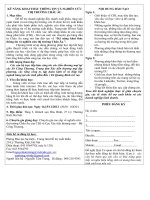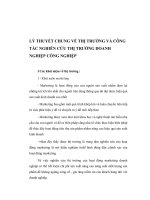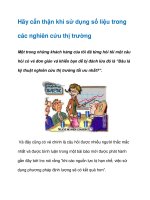Chương 3: Người dùng Internet và nghiên cứu thị trường docx
Bạn đang xem bản rút gọn của tài liệu. Xem và tải ngay bản đầy đủ của tài liệu tại đây (300.7 KB, 43 trang )
1
© Prentice Hall, 2000
Chapter 3
Internet Consumers and
Market Research
2
© Prentice Hall, 2000
Learning Objectives
❚
Describe the essentials of consumer behavior
❚
Describe the characteristics of Internet surfers and EC
purchasers
❚
Understand the process of consumer purchasing decision making
❚
Describe the way companies are building relationships with
customers
❚
Explain the implementation of customer service
❚
Describe the consumer market research in EC
❚
Experience the role of intelligent agents in consumer applications
❚
Describe the organizational buyer behavior model
3
© Prentice Hall, 2000
The Importance of Customers
❙
Competition
❘
“fighting” on customers
❘
to succeed : control the 3Cs
❙
Customers
❘
customers becomes a King/Queen
❘
to succeed : finding and retaining customers
❙
Change
❘
EC is a new distribution channel
❘
to succeed : convince customers to go online and
then to choose your company over the online
competitors
❚
The major pressures are labeled the 3Cs
4
© Prentice Hall, 2000
A Model of EC Consumer Behavior
❚
Purchasing
decision
begins with
customer’s
reaction to
stimuli
Vendors’ controlled System
Logistic
Support
Payments,
Delivery
Technical
Support
Web design,
Intelligent-
agents
Customer
service
FAQ,
e-mail,
Call centers,
One-to-one
Decision
Making
Process
Stimuli
Marketing
Price
Promotion
Product
Quality
Others
Economical
Technology
Political
Cultural
Buyers’ Decisions
Buy or not
What to buy
Where (vendor)
When
How much to spend
Repeat purchases
Individual
Characteristics
Age, gender, ethnicity,
education, lift style,
psychological, knowledge,
values, personality
Environment
Characteristics
Social, family,
communities
5
© Prentice Hall, 2000
❚
Consumer Types
❙
Individual consumers: get much of the media attention
❙
Organizational buyers: do most of the shopping in cyberspace
❚
Purchasing Types
❙
Impulsive buyers: purchase products quickly
❙
Patient buyers: purchase products after making some comparisons
❙
Analytical buyers: do substantial research before making the decision to
purchase products or services
❚
Purchasing Experiences
❙
Utilitarian: shopping “to achieve a goal” or “complete a task”
❙
Hedonic: shopping because “it is fun and I love it”
A Model of EC Consumer Behavior (cont.)
Variables Influencing
Decision Making Process
❚
Environmental Variables
❙
Social variables
❘
people influenced by family members, friends, co-
workers, “what’s in fashion this year”, Internet
communities and discussion groups
❙
Cultural variables
❙
Psychology variables
❙
Other environmental variables
❘
available information, government regulations,
legal constraints, and situational factors
6
7
© Prentice Hall, 2000
Consumer Demographics
❙
Gender (61% male user & 39% female user)
WOMEN’S PURCHASES BY CATEGORY (1998)
Purchases Category
% of Total Category
Purchases (299)
% of Total Respondents
Buying (166)
Computer Software 15% 39%
Books 14% 35%
Music 11% 28%
Magazines 11% 28%
Flowers 11% 28%
Women’s Clothing 7% 19%
Computer Hardware 5% 12%
Games 5% 11%
Videos 4% 10%
Crafts & Craft Supplier 4% 10%
Toys 3% 9%
Home Furnishings 2% 6%
Children’s Clothing 2% 4%
Men’s Clothing 2% 4%
Art 2% 4%
Jewelry 1% 3%
Furniture 1% 2%
TOTAL 100%
❚
Consumer Demographics (1998)
Variables Influencing Decision
Making Process (c ont.)
❙
Age (mostly 21-30 year-old)
❙
Marital status (41% married & 39% single)
❙
Educational level (81% with at least some college
education & 50% obtained at least baccalaureate
degree)
❙
Ethnicity (87% white in America)
❙
Occupation (26% educational-related field, 22%
computers & 22% other professionals)
© Prentice Hall, 2000 8
Variables Influencing Decision
Making Process (c ont.)
❚
Consumer Demographics
❙
Household income (46% at least $50,000/year)
❙
Internet usage profile (Internet access option, length
and frequency of web use & access cost)
❙
Internet access option (63% primarily form home & 58%
primarily from work or school)
❙
Length and frequency of use (88% access daily & 33%
access 10-20 hours a week)
❙
Access cost (67% pay for their own Internet access &
31% paid for by their employers)
© Prentice Hall, 2000 9
10
© Prentice Hall, 2000
Consumer Buying Patterns
In last six months of 1998:
❙
76% filling out a form on the Web
❙
Online purchases are more than
paper catalog purchases for Net
buyers
❙
32% spent between $100.00-
$500.00
❙
Spending of less than $50.00
decreases steadily as shoppers
gain experience
❙
Women are more likely to
purchase more in the under $50.00
level, and less likely to purchase at
the above $500.00 level
0
10
20
30
40
50
P e rc e n t
less
than
$50
$50-
$100
$100-
$500
$500
or
more
Don't
know
Amount Spent on Web
in Last 6 Months of 1998
< 1 Year
1 - 3 Years
> 4 Years
Experience:
11
© Prentice Hall, 2000
Consumer Purchasing Decision-Making
❚
Roles that people play in the decision making
process
❙
Initiator : the person who first suggests or thinks of
the idea of buying a particular product or service
❙
Influencer : a person whose advice or views carry
some weight in making a final buying decision
❙
Decider : the person who ultimately makes a buying
decision or any part of it - whether to buy, what to buy,
how to buy, or where to buy
❙
Buyer : the person who makes an actual purchase
❙
User : the person who consumes or uses a product or
service
12
© Prentice Hall, 2000
After purchase service
and evaluation
Purchase and delivery
Alternative evaluation,
negotiation and selection
Information search
(What? From whom?)
❚
The Purchasing Decision-Making Model
Consumer Purchasing Decision-Making
(cont.)
Need identification
(Recognition)
13
© Prentice Hall, 2000
Model of Internet Consumer Satisfaction
Customer
Satisfaction
Logistics Support
Customer Service
Pricing Attractiveness
Web-site Store Front
3rd Party
Seal of Approval
Trust in
Web-shopping
Vendor
Reputation
Repeat Web Purchase
(Brand Loyalty)
Security
Authentication
Privacy Transaction
Safety
Non-repudiationIntegrity
System
Reliability
Speed of
Operation
Ease of
Use
Content,
Quality
Format
Reliability
Completeness
Timeliness
14
© Prentice Hall, 2000
One-to-One Marketing
❚
Relationship marketing
❙
“Overt attempt of exchange partners to build a long
term association, characterized by purposeful
cooperation and mutual dependence on the
development of social, as well as structural, bonds”
❚
“Treat different customers differently”
❙
Able to change the manner its products are
configured or its service is delivered, based on the
individual needs of individual customers
15
© Prentice Hall, 2000
One-to-One Marketing (c ont.)
❚
Customer loyalty
❙
Purchase behavior
❙
One of the most significant contributors to profitability
❙
Increase profits; strengthen market position; become
less sensitive to price competition; increase cross-
selling success; save cost, etc.
❙
Real world examples
❘
1-800-FLOWERS
❘
Amazon.com
❘
Federal Express (FedEx)
16
© Prentice Hall, 2000
❚
Building and maintaining customer loyalty
One-to-One Marketing (c ont.)
❙
Maintain continuous interactions between
consumers and business
❙
Make a commitment to provide all aspects of the
business online
❙
Build different sites for different levels of
customers
❙
Willing to invest capital, both human and
financial, in the information systems, to insure
continuous improvement in the supporting
technology as it becomes available
17
© Prentice Hall, 2000
❚
Building and maintaining customer loyalty
One-to-One Marketing (c ont.)
❙
Make a commitment to use the information
collected about customers in an ethical manner
❙
Realistic managerial expectations in the payback
period and cost recovery
❙
Set acceptable standards for response time in
customer service (24-48 hours); Use intelligent
agents to expedite and standardize responses
whenever possible
❙
Ability to change and customize information and
services quickly and inexpensively is a must
18
© Prentice Hall, 2000
❚
Customer Service
❙
A new look and feel
Install Web servers
which allow each
customer to create
individual web pages
that can be customized
to record purchases
and preferences
Put the burden on the
customer to treat a
problem or inquiry and
receive information
bit by bit
One-to-One Marketing (c ont.)
19
© Prentice Hall, 2000
❚
Customer Service
ISFLAVIA:
ISFLAVIA:
One-to-One Marketing (c ont.)
❙
Information can be directed to the customer efficiently
❙
Creation of a database which records purchases,
problems and requests is facilitated
❙
Information can now be traced and analyzed for
immediate response
❙
If customer service options and solutions do not maintain
the same level of excitement and interaction as the
advertising and sales presentations, the level of intensity
declines and the vendor runs the risk of losing customers
Implementing Customer Service in
Cyberspace
❚
Product Life Cycle
❙
Phase 1. Requirements : assisting the customer
to determine needs
❙
Phase 2. Acquisition : helping the customer to
acquire a product or
service
❙
Phase 3. Ownership : supporting the customer on
an ongoing basis
❙
Phase 4. Retirement : helping the client to
dispose of a service or
product
© Prentice Hall, 2000 20
❚
Types of Customer Service Functions
Implementing Customer Service in
Cyberspace (cont.)
❙
Answering customer inquires
❙
Providing technical and other information
❙
Letting customers track accounts or order
status
❙
Allowing customers to customize and
order online
© Prentice Hall, 2000 21
❚
Addressing Individual Customer Needs
Doing
business
via Web
Companies
understand their
customers’ needs
and buying habits
better
Companies
customize their
future marketing
efforts
Implementing Customer Service in
Cyberspace (cont.)
© Prentice Hall, 2000 22
23
© Prentice Hall, 2000
Tools of Customer Service
❚
Personalized Web Pages
❙
used to record purchases and preference
❙
direct customized information to customers efficiently
❚
Chat Room
❙
discuss issues with company experts; with other
customers
❚
❙
used to disseminate information, send product
information and conduct correspondence regarding any
topic, but mostly inquiries from customers
❚
FAQs
❙
not customized, no personalized feeling and contribution
to relationship marketing
24
© Prentice Hall, 2000
❚
Help Desks and Call Centers
Tools of Customer Service (cont.)
❙
A comprehensive customer service entity
❙
EC vendors take care of customer service issues
communicated through various contact channels
❙
Telewebs
❘
combines Web channels, such as automated e-mail reply,
Web knowledge bases and portal-like self service with call
center agents or field service personnel
❙
Internet
❘
a medium of instant gratification
❘
demand for both prompt replies and proactive alerts
25
© Prentice Hall, 2000
Market Research for EC
❚
Aims
Problem definition
and
Research
objectives
Research
methodology,
Data collection
plan
Data
collection,
Data analysis
Results,
Recommendations,
Implementation
❙
Finding relationship between consumers, products,
marketing methods, and marketers through
information in order to discover marketing
opportunities and issues, to establish marketing
plans, to better understand the purchasing process,
and to evaluate marketing performance









